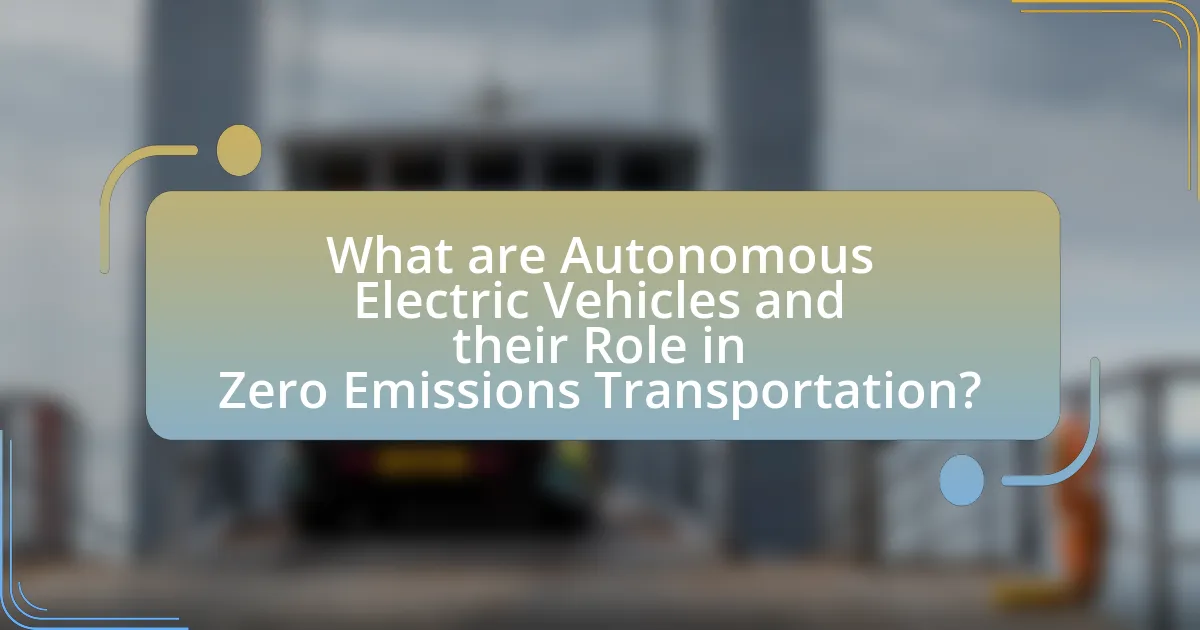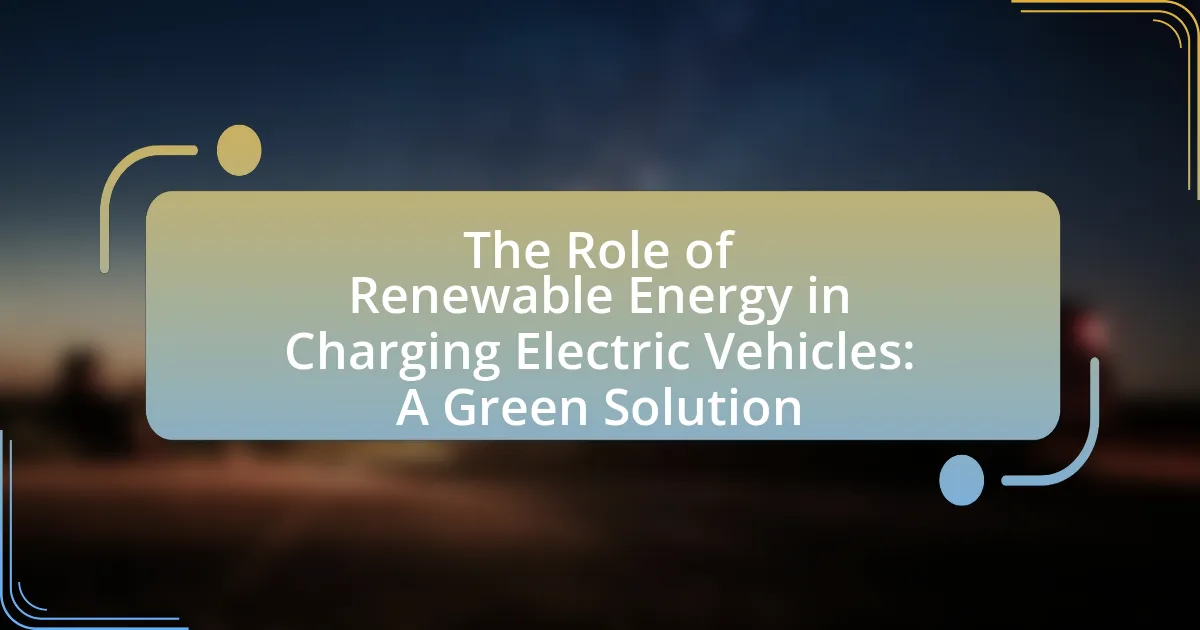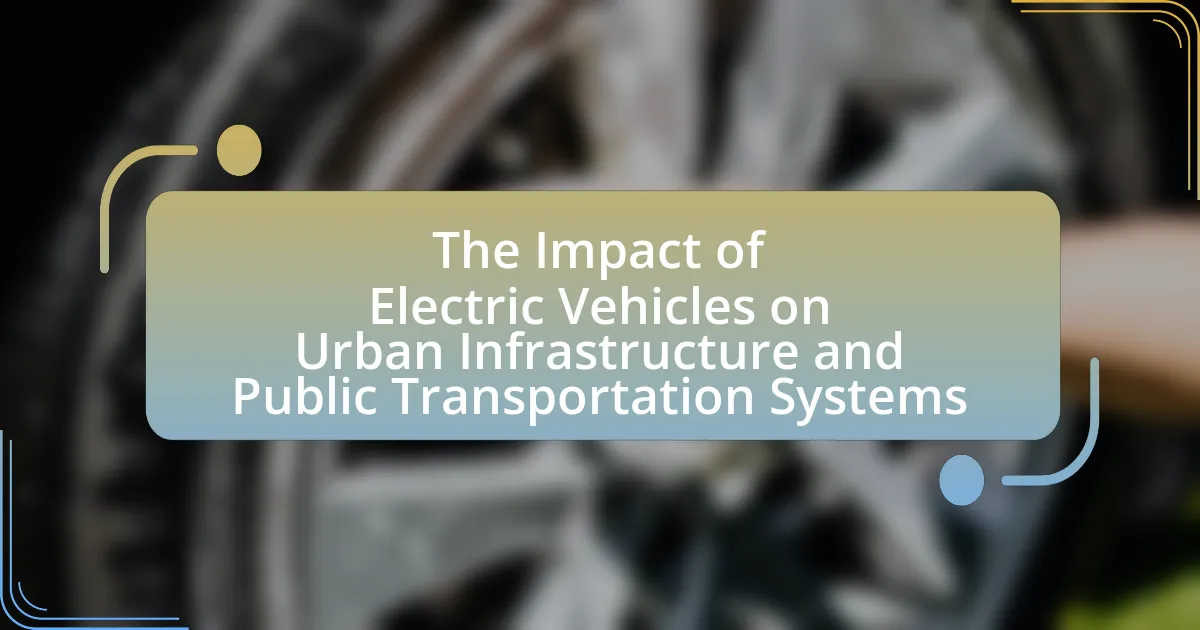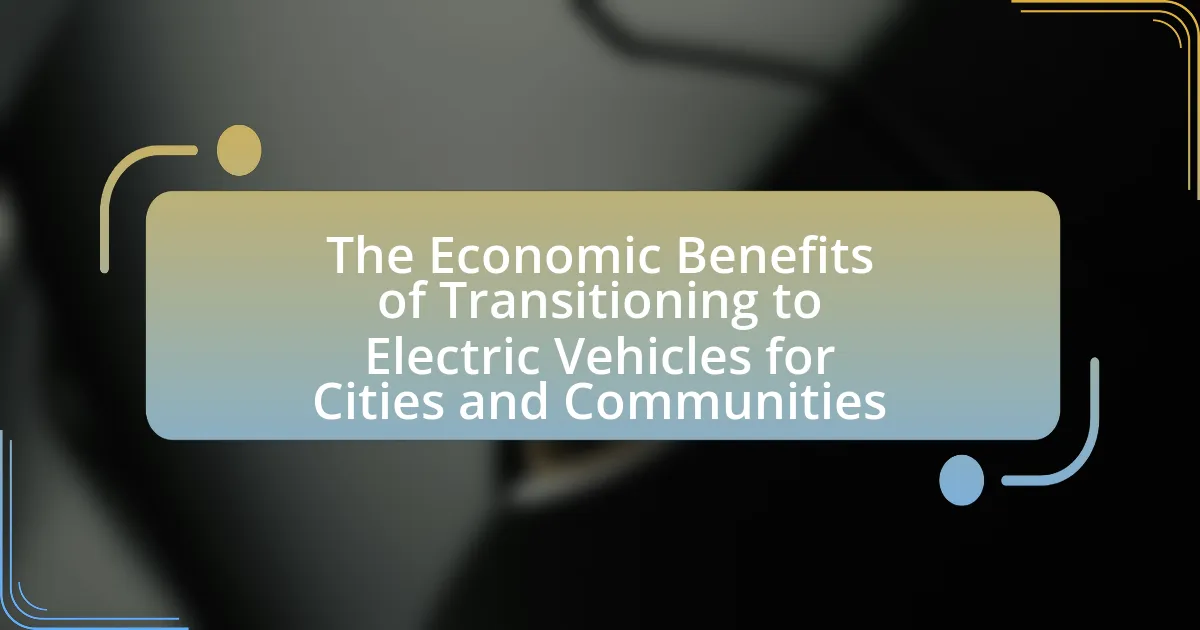Autonomous Electric Vehicles (AEVs) are self-driving cars powered by electric energy, designed to operate without human intervention, and play a vital role in achieving zero emissions transportation. This article explores the functioning of AEVs, the technologies enabling their autonomy, and the environmental benefits of electric drivetrains. It also addresses the challenges AEVs face, including battery production emissions, regulatory hurdles, and public acceptance issues. Furthermore, the article highlights advancements in AI, sensor technology, and battery efficiency that are shaping the future of AEVs, along with best practices and partnerships essential for promoting their adoption and supporting zero emissions goals.

What are Autonomous Electric Vehicles and their Role in Zero Emissions Transportation?
Autonomous Electric Vehicles (AEVs) are self-driving cars powered by electric energy, designed to operate without human intervention. AEVs play a crucial role in zero emissions transportation by eliminating reliance on fossil fuels, thereby reducing greenhouse gas emissions. According to the International Energy Agency, electric vehicles can reduce CO2 emissions by up to 70% compared to conventional vehicles, especially when charged from renewable energy sources. Furthermore, the integration of autonomous technology enhances traffic efficiency and reduces congestion, leading to lower energy consumption and emissions overall.
How do Autonomous Electric Vehicles function?
Autonomous electric vehicles function by integrating advanced sensors, artificial intelligence, and electric propulsion systems to navigate and operate without human intervention. These vehicles utilize a combination of cameras, radar, and lidar to perceive their surroundings, allowing them to detect obstacles, lane markings, and traffic signals. The onboard AI processes this data in real-time to make driving decisions, such as acceleration, braking, and steering.
Electric propulsion systems power these vehicles, providing a zero-emission alternative to traditional gasoline engines. According to the International Energy Agency, electric vehicles can reduce greenhouse gas emissions significantly, especially when charged from renewable energy sources. This combination of autonomous technology and electric power contributes to the goal of achieving zero emissions in transportation.
What technologies enable autonomy in electric vehicles?
Technologies that enable autonomy in electric vehicles include advanced sensors, artificial intelligence, machine learning algorithms, and vehicle-to-everything (V2X) communication systems. Advanced sensors, such as LiDAR, radar, and cameras, provide real-time data about the vehicle’s surroundings, allowing for accurate perception and navigation. Artificial intelligence and machine learning algorithms process this data to make decisions and improve driving performance over time. V2X communication systems facilitate interaction between vehicles and infrastructure, enhancing safety and efficiency. These technologies collectively contribute to the development of fully autonomous electric vehicles, which are essential for achieving zero emissions transportation.
How do electric drivetrains contribute to zero emissions?
Electric drivetrains contribute to zero emissions by utilizing electric motors powered by batteries instead of internal combustion engines that burn fossil fuels. This shift eliminates tailpipe emissions, which are a significant source of air pollution and greenhouse gases. According to the U.S. Environmental Protection Agency, electric vehicles produce no direct emissions, making them a cleaner alternative to traditional vehicles. Additionally, when charged using renewable energy sources, the overall lifecycle emissions of electric drivetrains can be significantly reduced, further supporting the goal of zero emissions in transportation.
Why is achieving zero emissions important for transportation?
Achieving zero emissions is crucial for transportation because it significantly reduces air pollution and mitigates climate change. Transportation is a major contributor to greenhouse gas emissions, accounting for approximately 29% of total U.S. emissions in 2020, according to the Environmental Protection Agency. By transitioning to zero-emission vehicles, such as electric and hydrogen-powered options, the sector can lower its carbon footprint, improve public health by decreasing harmful pollutants, and contribute to global efforts to limit temperature rise to 1.5 degrees Celsius as outlined in the Paris Agreement.
What are the environmental impacts of traditional vehicles?
Traditional vehicles significantly contribute to environmental degradation through greenhouse gas emissions, air pollution, and resource depletion. Specifically, internal combustion engines release carbon dioxide, nitrogen oxides, and particulate matter, which are linked to climate change and respiratory health issues. According to the Environmental Protection Agency, transportation accounts for approximately 29% of total greenhouse gas emissions in the United States, with traditional vehicles being the primary source. Additionally, the extraction and refining of fossil fuels for these vehicles lead to habitat destruction and water contamination, further exacerbating environmental harm.
How do emissions regulations influence the automotive industry?
Emissions regulations significantly influence the automotive industry by mandating lower greenhouse gas emissions and promoting the development of cleaner technologies. These regulations compel manufacturers to invest in research and development of electric and hybrid vehicles, as seen in the European Union’s stringent CO2 emission targets, which require automakers to reduce average emissions to 95 grams per kilometer by 2021. Consequently, companies like Volkswagen and Tesla have accelerated their transition towards electric vehicles to comply with these standards, reflecting a broader industry shift towards sustainability.

What advancements are shaping the future of Autonomous Electric Vehicles?
Advancements in artificial intelligence, sensor technology, and battery efficiency are significantly shaping the future of Autonomous Electric Vehicles (AEVs). Artificial intelligence enhances decision-making capabilities, allowing vehicles to navigate complex environments safely. For instance, companies like Waymo and Tesla utilize advanced machine learning algorithms to improve real-time data processing and predictive analytics, which are crucial for autonomous driving.
Sensor technology, including LiDAR, radar, and cameras, provides AEVs with a comprehensive understanding of their surroundings, enabling them to detect obstacles and respond to dynamic conditions. According to a report by McKinsey, the integration of these sensors is expected to reduce accident rates by up to 90% in the next decade.
Battery efficiency advancements, such as solid-state batteries and fast-charging technologies, are also pivotal. These innovations not only extend the driving range of AEVs but also reduce charging times, making electric vehicles more practical for consumers. Research from the International Energy Agency indicates that improvements in battery technology could lead to a 30% reduction in costs by 2030, further promoting the adoption of AEVs.
Together, these advancements are driving the evolution of Autonomous Electric Vehicles, positioning them as a key component in achieving zero emissions transportation.
How is artificial intelligence enhancing vehicle autonomy?
Artificial intelligence is enhancing vehicle autonomy by enabling advanced perception, decision-making, and control systems. AI algorithms process vast amounts of data from sensors, such as cameras and LiDAR, allowing vehicles to accurately interpret their surroundings. For instance, Tesla’s Autopilot utilizes deep learning to recognize objects and predict their movements, improving safety and navigation. Additionally, AI-driven systems optimize route planning and energy management, contributing to more efficient electric vehicle operation. According to a report by McKinsey, AI technologies can reduce the time needed for autonomous vehicle development by up to 30%, accelerating the transition to zero-emissions transportation.
What role does machine learning play in navigation and safety?
Machine learning plays a crucial role in navigation and safety by enabling autonomous vehicles to process vast amounts of data from sensors and make real-time decisions. This technology enhances route optimization, obstacle detection, and predictive analytics, which are essential for safe navigation. For instance, machine learning algorithms analyze data from cameras, LIDAR, and radar to identify pedestrians, cyclists, and other vehicles, significantly reducing the likelihood of accidents. According to a study by the National Highway Traffic Safety Administration, advanced driver-assistance systems that utilize machine learning can decrease crash rates by up to 40%. This demonstrates the effectiveness of machine learning in improving both navigation accuracy and overall safety in autonomous electric vehicles.
How do sensor technologies improve vehicle perception?
Sensor technologies enhance vehicle perception by providing real-time data about the vehicle’s surroundings, enabling better decision-making for autonomous systems. These technologies, including LiDAR, radar, and cameras, allow vehicles to detect obstacles, lane markings, and traffic signals with high precision. For instance, LiDAR can create a detailed 3D map of the environment, which improves spatial awareness and object recognition. Studies show that vehicles equipped with advanced sensor technologies can reduce accident rates by up to 40%, demonstrating their effectiveness in enhancing safety and operational efficiency.
What innovations are being developed in electric vehicle battery technology?
Innovations in electric vehicle battery technology include solid-state batteries, lithium-sulfur batteries, and advancements in fast-charging capabilities. Solid-state batteries, which utilize a solid electrolyte instead of a liquid one, promise higher energy density and improved safety, potentially increasing the range of electric vehicles significantly. Lithium-sulfur batteries are being developed to offer a higher theoretical energy capacity than traditional lithium-ion batteries, which could lead to lighter and more efficient energy storage solutions. Additionally, advancements in fast-charging technology aim to reduce charging times to as little as 10 minutes, enhancing the convenience of electric vehicle use. These innovations are supported by ongoing research and development efforts from companies like Toyota and QuantumScape, which are actively working to bring these technologies to market.
How do advancements in battery capacity affect vehicle range?
Advancements in battery capacity directly increase vehicle range by allowing electric vehicles to store more energy. For instance, improvements in lithium-ion battery technology have led to energy densities exceeding 250 Wh/kg, enabling vehicles to travel longer distances on a single charge. This is evidenced by models like the Tesla Model S, which can achieve ranges over 370 miles due to its high-capacity battery. Enhanced battery capacity not only extends the driving range but also reduces the frequency of charging, making electric vehicles more convenient and practical for consumers.
What are the implications of fast-charging technologies for adoption?
Fast-charging technologies significantly enhance the adoption of electric vehicles (EVs) by reducing charging time and increasing convenience for users. With charging times comparable to refueling traditional gasoline vehicles, fast-charging solutions can alleviate range anxiety, a major barrier to EV adoption. For instance, a study by the International Council on Clean Transportation found that widespread deployment of fast-charging stations could increase EV sales by up to 50% in urban areas. Additionally, fast-charging infrastructure supports the growth of autonomous electric vehicles, as these vehicles require efficient energy replenishment to operate effectively in various environments.

What challenges do Autonomous Electric Vehicles face in achieving zero emissions?
Autonomous Electric Vehicles (AEVs) face several challenges in achieving zero emissions, primarily related to battery production, energy sourcing, and infrastructure. The production of lithium-ion batteries, essential for AEVs, generates significant carbon emissions due to mining and manufacturing processes. For instance, a study by the International Council on Clean Transportation indicates that battery production can account for up to 50% of the total lifecycle emissions of an electric vehicle.
Additionally, the source of electricity used to charge AEVs plays a crucial role in their overall emissions. If the electricity comes from fossil fuels, the vehicles cannot be considered truly zero emissions. According to the U.S. Energy Information Administration, as of 2021, about 60% of electricity in the United States was generated from fossil fuels.
Furthermore, the lack of adequate charging infrastructure can hinder the widespread adoption of AEVs, limiting their potential to replace traditional vehicles. A report from the International Energy Agency highlights that achieving a robust charging network is essential for supporting the transition to electric mobility. These challenges collectively impede the goal of zero emissions for Autonomous Electric Vehicles.
What are the regulatory hurdles for autonomous vehicles?
Regulatory hurdles for autonomous vehicles include the lack of comprehensive legislation, varying state and federal regulations, and safety standards that must be met before deployment. The absence of a unified regulatory framework creates confusion for manufacturers and limits testing and deployment opportunities. For instance, as of 2023, only a few states in the U.S. have enacted laws specifically addressing autonomous vehicle operation, leading to a patchwork of regulations that complicate interstate travel and commerce. Additionally, safety standards established by organizations like the National Highway Traffic Safety Administration (NHTSA) are still evolving, which can delay the approval process for new technologies.
How do safety standards impact the deployment of autonomous technology?
Safety standards significantly influence the deployment of autonomous technology by establishing the necessary criteria for operational safety and reliability. These standards ensure that autonomous systems, such as self-driving vehicles, meet specific performance benchmarks to minimize risks to users and the public. For instance, the National Highway Traffic Safety Administration (NHTSA) has developed guidelines that require extensive testing and validation of autonomous systems before they can be deployed on public roads. Compliance with these standards not only enhances public trust but also facilitates regulatory approval, which is crucial for widespread adoption. Furthermore, adherence to safety standards can lead to reduced liability for manufacturers, as demonstrated by the increased investment in autonomous technology by companies that prioritize compliance with established safety protocols.
What are the challenges in public acceptance of autonomous vehicles?
The challenges in public acceptance of autonomous vehicles include safety concerns, trust issues, and ethical dilemmas. Safety concerns arise from the fear of accidents and the reliability of technology, as studies indicate that 70% of people worry about the potential for crashes involving self-driving cars. Trust issues stem from skepticism about the technology’s ability to make safe decisions in complex driving environments, with surveys showing that only 20% of individuals feel comfortable riding in fully autonomous vehicles. Ethical dilemmas involve questions about decision-making in unavoidable accident scenarios, which complicate public perception and acceptance. These factors collectively hinder the widespread adoption of autonomous vehicles.
How does infrastructure need to evolve to support these vehicles?
Infrastructure must evolve to include extensive charging networks, dedicated lanes, and smart traffic management systems to support autonomous electric vehicles. The expansion of charging stations is crucial, as studies indicate that a robust network can alleviate range anxiety and encourage adoption; for instance, the International Energy Agency reported that the number of public charging points must increase significantly to meet future demand. Additionally, dedicated lanes for autonomous vehicles can enhance traffic flow and safety, as demonstrated by pilot programs in cities like San Francisco. Smart traffic management systems utilizing real-time data can optimize routes and reduce congestion, further supporting the efficiency of these vehicles.
What role do charging stations play in the widespread adoption of electric vehicles?
Charging stations are critical for the widespread adoption of electric vehicles (EVs) as they provide the necessary infrastructure for recharging, thereby alleviating range anxiety among potential users. The availability of a robust network of charging stations increases consumer confidence, making EVs a more viable option for daily transportation. According to the International Energy Agency, the number of public charging points worldwide reached over 1.3 million in 2020, demonstrating significant growth in infrastructure that supports EV usage. This expansion is essential for meeting the projected demand for electric vehicles, which is expected to rise as governments implement stricter emissions regulations and consumers seek sustainable alternatives.
How can smart city initiatives facilitate the integration of autonomous vehicles?
Smart city initiatives can facilitate the integration of autonomous vehicles by implementing advanced infrastructure, data-sharing platforms, and regulatory frameworks. These initiatives often include the development of smart traffic management systems that utilize real-time data to optimize traffic flow, which is essential for the safe operation of autonomous vehicles. For instance, cities like San Francisco and Singapore have deployed connected traffic signals that communicate with autonomous vehicles, allowing for smoother navigation and reduced congestion. Additionally, smart cities promote the establishment of dedicated lanes and charging stations for electric autonomous vehicles, further enhancing their operational efficiency. The integration of these technologies not only supports the functionality of autonomous vehicles but also aligns with sustainability goals, contributing to the broader objective of achieving zero emissions in transportation.
What are the best practices for promoting the adoption of Autonomous Electric Vehicles?
The best practices for promoting the adoption of Autonomous Electric Vehicles (AEVs) include enhancing public awareness, developing supportive policies, and investing in infrastructure. Public awareness campaigns can educate consumers about the benefits of AEVs, such as reduced emissions and lower operating costs, which can increase acceptance and interest. Supportive policies, including tax incentives and subsidies, can make AEVs more financially attractive to consumers and businesses. Additionally, investing in charging infrastructure is crucial, as it alleviates range anxiety and ensures that AEVs are convenient to use. According to a study by the International Council on Clean Transportation, regions with robust charging networks see a higher adoption rate of electric vehicles, demonstrating the importance of infrastructure in promoting AEVs.
How can public awareness campaigns influence consumer behavior?
Public awareness campaigns can significantly influence consumer behavior by educating individuals about the benefits and importance of adopting sustainable practices, such as using autonomous electric vehicles. These campaigns often utilize targeted messaging and data-driven strategies to highlight the environmental impact of traditional vehicles, showcasing statistics that demonstrate the reduction in emissions achieved through electric alternatives. For instance, a study by the International Council on Clean Transportation found that electric vehicles can reduce greenhouse gas emissions by up to 70% compared to gasoline-powered cars. By effectively communicating these advantages, public awareness campaigns can shift consumer preferences towards more eco-friendly transportation options, ultimately driving demand for autonomous electric vehicles and contributing to the goal of zero emissions transportation.
What partnerships are essential for advancing zero emissions transportation?
Strategic partnerships between governments, private companies, and research institutions are essential for advancing zero emissions transportation. Governments can provide regulatory frameworks and incentives, while private companies contribute technology and infrastructure development. Research institutions play a critical role in innovation and testing new solutions. For example, collaborations like the California Air Resources Board’s partnerships with automakers have led to significant advancements in electric vehicle technology and infrastructure, demonstrating the effectiveness of such alliances in achieving emissions reduction goals.





